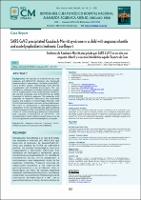SARS-CoV-2 precipitated Kasabach-Merritt syndrome in a child with angioma infantile and acute lymphoblastic leukemia: Case Report
Related Resource(s)
http://cmhnaaa.org.pe/ojs/index.php/rcmhnaaa/article/view/1278Date
2021-12-16Author(s)
Zarate, Vanessa
Cahuata, Alejandra
Díaz, Roxana
Alvarado Gamarra, Giancarlo
Chonlon, Kenny
Domínguez Rojas, Jesús Angel
Metadata
Show full item recordAlternate title
Síndrome de Kasabach-Merritt precipitado por SARS-CoV-2 en un niño con angioma infantil y leucemia linfoblástica aguda: Reporte de Caso
Abstract
Introducción: Describimos a un niño de 8 meses con leucemia e infección por SARS-CoV-2 que desarrolló el fenómeno de Kasabach-Merritt. Tenía una muestra de RT-PCR de SARS-COV-2 positiva. Las pruebas hematológicas mostraron coagulopatía y afectación intestinal. Fue manejada en emergencia recibiendo apoyo transfusional y en hospitalización con medidas de aislamiento social, inició propanolol y corticoterapia como tratamiento inicial de los angiomas infantiles. Presentó síntomas de obstrucción intestinal y fue intervenida quirúrgicamente y se evidenció infarto hemorrágico con focos de necrosis isquémica intestinal, terminando en ileostomía. Intentamos comprender una explicación fisiopatológica de la afectación dermatológica y del tracto gastrointestinal por el virus y la forma atípica de COVID-19. Dada la evidencia emergente de la afectación endotelial y vascular en COVID-19, el desarrollo de pruebas para detectar lesiones vasculares puede ser crítico para guiar el uso de nuevas estrategias terapéuticas. Background: We describe an 8-month-old boy with
leukemia and SARS-CoV-2 infection who developed
Kasabach-Merritt phenomenon. He had a positive SARSCOV-
2 RT-PCR sample. Hematologic tests showed
coagulopathy and intestinal involvement. She was
managed in emergency receiving transfusion support
and in hospitalization with social isolation measures,
she started propanolol and corticotherapy as initial
treatment of infantile angiomas. She presented with
symptoms of intestinal obstruction and underwent
surgery and evidence of hemorrhagic infarction with
foci of intestinal ischemic necrosis, ending in ileostomy.
We tried to understand a pathophysiological
explanation of the dermatologic and gastrointestinal
tract involvement by the virus and the atypical form of
COVID-19. Given the emerging evidence of endothelial
a n d v a s c u l a r i n v o l v e m e n t i n C O V I D - 1 9 , t h e
development of tests to detect vascular lesions may be
critical to guide the use of new therapeutic strategies.






